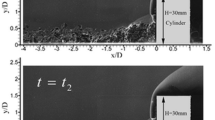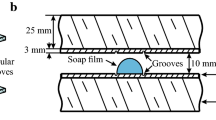Abstract
Scaling parameters of shock-wave/turbulent boundary-layer interactions generated by a semi-infinite standing cylinder were explored in a combined numerical and experimental effort, consisting of Reynolds-averaged Navier–Stokes simulations and high-speed schlieren imaging. The primary interaction variable, the cylinder diameter (d), and a secondary interaction variable, the boundary-layer thickness (\(\delta \)), were varied to study the effects of the parameter \(d/\delta \). This was found to be an appropriate scaling parameter for mean features. The characteristic interaction variables (the maximum separation distance, S, and the triple-point height, \(h_\mathrm{tp}\)) followed a linear trend when normalized as \(S/\delta \) and \(h_\mathrm{tp}/\delta \); however, when the boundary layer became larger than the cylinder diameter, a power law trend became more representative. The parameter \(d/\delta \) also determined the role that viscous effects have on the strength of the interaction, where a lower \(d/\delta \) was characterized by a greater interaction scale and lower surface pressure peaks. Moreover, the high surface pressure on the cylinder leading edge due to the Edney interaction was found to be reduced for \(d/\delta \le 0.45\), as the boundary layer encompassed the lambda-shock structure. Trends in the shapes or peaks of the auto-spectral density function were not observed based on \(d/\delta \), but appeared to be dominated by broadband low-frequency (\(f < 1~\hbox {kHz}\)) content. While the position and structure of the interaction may change as a result of varying \(d/\delta \), the effects on the unsteady dynamics were minimal.


















Similar content being viewed by others
References
Gaitonde, D.V.: Progress in shock wave/boundary layer interactions. Prog. Aerosp. Sci. 72, 80–99 (2015). https://doi.org/10.1016/j.paerosci.2014.09.002
Dolling, D.S.: Fifty years of shock-wave/boundary-layer interaction research: what next? AIAA J. 39(8), 1517–1531 (2001). https://doi.org/10.2514/2.1476
Clemens, N.T., Narayanaswamy, V.: Low-frequency unsteadiness of shock wave/turbulent boundary layer interactions. Annu. Rev. Fluid Mech. 46, 469–492 (2014). https://doi.org/10.1146/annurev-fluid-010313-141346
Knight, D.D., Degrez, G.: Shock wave boundary layer interactions in high Mach number flows: a critical survey of current numerical prediction capabilities. AGARD Advisory Report AR-319, 2(1) (1998)
Hankey Jr., W.L., Holden, M.S.: Two-dimensional shock wave-boundary layer interactions in high speed flows. AGARDograph No. 203 (1975)
Délery, J., Marvin, J.: Shock-wave boundary-layer interactions. AGARDograph No. 280 (1986)
Knight, D.D., Yan, H., Panaras, A.G., Zheltovodov, A.A.: Advances in CFD prediction of shock wave turbulent boundary layer interactions. Prog. Aerosp. Sci. 39, 121–184 (2003). https://doi.org/10.1016/S0376-0421(02)00069-6
Holden, H.A., Babinsky, H.: Separated shock-boundary-layer interaction control using streamwise slots. J. Aircr. 42(1), 166–171 (2005). https://doi.org/10.2514/1.4687
Korkegi, R.H.: Survey of viscous interactions associated with high Mach number flight. AIAA J. 9(5), 771–784 (1971). https://doi.org/10.2514/3.6275
Blevins, R.D., Holehouse, I., Wentz, K.R.: Thermoacoustic loads and fatigue of hypersonic vehicle skin panels. J. Aircr. 30(6), 971–978 (1993). https://doi.org/10.2514/3.46441
Hung, F.T., Greenschlag, S.N., Scottoline, C.A.: Shock-wave-boundary-layer interaction effects on aerodynamic heating. J. Spacecr. 14(1), 25–31 (1977). https://doi.org/10.2514/3.57157
Westkaemper, J.C.: Turbulent boundary-layer separation ahead of cylinders. AIAA J. 6(7), 1352–1355 (1968). https://doi.org/10.2514/3.4747
Dolling, D.S., Bogdonoff, S.M.: Scaling of interactions of cylinders with supersonic turbulent boundary layers. AIAA J. 19(5), 655–657 (1981). https://doi.org/10.2514/3.7805
Dolling, D.S., Bogdonoff, S.M.: Blunt fin-induced shock wave/turbulent boundary-layer interaction. AIAA J. 20(12), 1674–1680 (1982). https://doi.org/10.2514/3.8003
Brusniak, L., Dolling, D.S.: Physics of unsteady blunt-fin-induced shock wave/turbulent boundary-layer interaction. J. Fluid Mech. 273, 375–409 (1994). https://doi.org/10.1017/S0022112094001989
Price Jr., E.A., Stallings Jr., R.L.: Investigation of turbulent separated flows in the vicinity of fin-type protuberances at supersonic Mach numbers. NASA Technical Note TN-D-3804 (1967)
Mashburn, J.H.: Turbulent boundary layer separation ahead of cylinder protuberances in supersonic flow. The University of Texas at Austin Applied Research Laboratories Report ARL-TR-69-17 (1969)
Sedney, R., Kitchens Jr., C.W.: Separation ahead of protuberances in supersonic turbulent boundary layers. AIAA J. 15(4), 546–552 (1977). https://doi.org/10.2514/3.60658
Sykes, D.M.: The supersonic and low-speed flows past circular cylinders of finite length supported at one end. J. Fluid Mech. 12, 367–387 (1962). https://doi.org/10.1017/S0022112062000270
Young, F.L., Kaufman II, L.G., Korkegi, R.H.: Experimental investigation of interactions between blunt fin shock waves and adjacent boundary layers at Mach numbers 3 and 5. U.S. Air Force Aerospace Research Laboratories Report ARL-68-0214 (1968)
Kaufman II, L.G., Korkegi, R.H., Morton, L.C.: Shock impingement caused by boundary layer separation ahead of blunt fins. U.S. Air Force Aerospace Research Laboratories Report ARL-72-0118 (1972)
Hung, C.-M., Buning, P.G.: Simulation of blunt-fin-induced shock-wave and turbulent boundary-layer interaction. J. Fluid Mech. 154, 163–185 (1985). https://doi.org/10.1017/S0022112085001471
Fomison, N.R., Stollery, J.L.: The effects of sweep and bluntness on a glancing shock wave turbulent boundary layer interaction. AGARD Conference Proceedings No. 428 (1987)
Özcan, O., Yüceil, B.K.: Cylinder-induced shock-wave boundary-layer interaction. AIAA J. 30(4), 1130–1132 (1992). https://doi.org/10.2514/3.11039
Barnhart, P.J., Greber, I.: Experimental investigation of unsteady shock wave turbulent boundary layer interactions about a blunt fin. NASA Contractor Report No. 202334 (1997)
Burbank, P.G., Newlander, R.A., Collins, I.K.: Heat-transfer and pressure measurements on a flat-plate surface and heat-transfer measurements on attached protuberances in a supersonic turbulent boundary layer at Mach numbers of 2.65, 3.51, and 4.44. NASA Technical Note TN-D-1372 (1962)
Lucas, E.J.: Investigation of blunt fin-induced flow separation region on a flat plate at Mach numbers 2.5 to 4.0. AEDC Technical Report AEDC-TR-70-265 (1971)
Chapman, D.R., Kuehn, D.M., Larson, H.K.: Investigation of separated flows in supersonic and subsonic streams with emphasis on the effects of transition. NACA Technical Report NACA-TR-1356 (1958)
Dolling, D.S., Narlo II, J.C.: Driving mechanism of unsteady separation shock motion in hypersonic interactive flow. AGARD Conference Proceedings No. 428 (1987)
Combs, C.S., Schmisseur, J.D., Bathel, B.F., Jones, S.B.: Unsteady analysis of shock-wave/boundary-layer interaction experiments at Mach 4.2. AIAA J. 57(11), 4715–4724 (2019). https://doi.org/10.2514/1.J058073
Cottier, S.M., Combs, C.S., Vanstone, L.: Spectral proper orthogonal decomposition analysis of shock-wave/boundary-layer interactions. AIAA Aviation 2019 Forum, Dallas, TX, AIAA Paper 2019-3331 (2019). https://doi.org/10.2514/6.2019-3331
Combs, C.S., Lash, E.L., Kreth, P.A., Schmisseur, J.D.: Investigating unsteady dynamics of cylinder-induced shock-wave/transitional boundary-layer interactions. AIAA J. 56(4), 1588–1599 (2018). https://doi.org/10.2514/1.J056553
Kocher, B.D., Combs, C.S., Kreth, P.A., Schmisseur, J.D., Peltier, S.J.: Investigation of the effects of disturbed surface roughness on supersonic flows. 47th AIAA Fluid Dynamics Conference, Denver, CO, AIAA Paper 2017-4313 (2017). https://doi.org/10.2514/6.2017-4313
Rice, B.E., Bisek, N.J., Peltier, S.J., Hofferth, J.W.: Investigation of secondary motion in high speed flows. 55th AIAA Aerospace Sciences Meeting, Grapevine, TX, AIAA Paper 2017-0526 (2017). https://doi.org/10.2514/6.2017-0526
Schlichting, H.: Boundary Layer Theory, pp. 536–537. McGraw-Hill, New York (1962)
Combs, C.S., Kreth, P.A., Schmisseur, J.D., Lash, E.L.: Image-based analysis of shock-wave/boundary-layer interaction unsteadiness. AIAA J. 56(3), 1288–1293 (2018). https://doi.org/10.2514/1.J056390
Lash, E.L., Combs, C.S., Kreth, P.A., Schmisseur, J.D.: Study of the dynamics of transitional shock wave-boundary layer interactions using optical diagnostics. 47th AIAA Fluid Dynamics Conference, Denver, CO, AIAA Paper 2017-3123 (2017). https://doi.org/10.2514/6.2017-3123
Willert, C.E., Mitchell, D.M., Soria, J.: An assessment of high-power light-emitting diodes for high frame rate schlieren imaging. Exp. Fluids 53(2), 413–421 (2012). https://doi.org/10.1007/s00348-012-1297-1
Spalart, P.R., Allmaras, S.R.: A one-equation turbulence model for aerodynamic flows. 30th Aerospace Sciences Meeting and Exhibit, Reno, NV, AIAA Paper 1992-0439 (1992). https://doi.org/10.2514/6.1992-439
Mani, M., Babcock, D.A., Winkler, C.M., Spalart, P.R.: Predictions of a supersonic turbulent flow in a square duct. 51st AIAA Aerospace Sciences Meeting, Grapevine (Dallas/Ft. Worth Region), TX, AIAA Paper 2013-0860 (2013). https://doi.org/10.2514/6.2013-860
Lindörfer, S.A., Combs, C.S., Kreth, P.A., Schmisseur, J.D.: Numerical simulations of a cylinder-induced shock wave/boundary layer interaction. 55th AIAA Aerospace Sciences Meeting, Grapevine, TX, AIAA Paper 2017-0534 (2017). https://doi.org/10.2514/6.2017-0534
Oberkampf, W.L., Roy, C.J.: Verification and Validation in Scientific Computing, pp. 273–284. Cambridge University Press, Cambridge (2010). https://doi.org/10.1017/CBO9780511760396
Musker, A.J.: Explicit expression for the smooth wall velocity distribution in a turbulent boundary layer. AIAA J. 17(6), 655–657 (1979). https://doi.org/10.2514/3.61193
Babinsky, H., Harvey, J.K.: Shock Wave–Boundary-Layer Interactions. Cambridge University Press, New York (2011). https://doi.org/10.1017/CBO9780511842757
Edney, B.E.: Anomalous heat transfer and pressure distributions on blunt bodies at hypersonic speeds in the presence of an impinging shock. The Aeronautical Research Institute of Sweden FFA Report 115 (1968)
Winkelmann, A.E.: Experimental investigations of a fin protuberance partially immersed in a turbulent boundary layer at Mach 5. Naval Ordnance Laboratory Technical Report NOLTR 72-33 (1972)
Stephen, E.J., Morell, S.P., Decker, R., Hope, D.K., McLaughlin, T.: Flow interactions of small cylindrical protuberances and the supersonic turbulent boundary layer on a flat plate. 52nd Aerospace Sciences Meeting, National Harbor, MD, AIAA Paper 2014-0435 (2014). https://doi.org/10.2514/6.2014-0435
Saida, N.: Separation ahead of blunt fins in supersonic turbulent boundary-layers. In: Délery, J. (ed.) Turbulent Shear-Layer/Shock-Wave Interactions. Springer, New York (1985). https://doi.org/10.1007/978-3-642-82770-9_20
Navidi, W.C.: Statistics for Engineers and Scientists, pp. 505–508. McGraw-Hill, New York (2011)
Truitt, R.W.: Hypersonic turbulent boundary-layer interference heat transfer in vicinity of protuberances. AIAA J. 3(9), 1754–1755 (1965). https://doi.org/10.2514/3.3241
Acknowledgements
The authors would like to thank Datta Gaitonde of Ohio State University, Ryan Glasby of the University of Tennessee and Oak Ridge National Laboratory Joint Institute for Computational Sciences (JICS), and James Coder of the University of Tennessee, Knoxville, for their advice and assistance on this research. In addition, the authors would like to thank Joel Davenport, Andrew Davis, Jonathan Kolwyck, E. Lara Lash, Katherine Stamper, Autumn Douthitt, Matthew Schwartz, and Samantha Golter of UTSI for their assistance in the execution of the experiments, as well as Gary Payne and Jack LeGeune for their assistance in the fabrication of the test models. This material is based upon research supported by the US Office of Naval Research Under Award Number N00014-15-1-2269. This work was also internally funded by the University of Tennessee Space Institute.
Author information
Authors and Affiliations
Corresponding author
Additional information
Communicated by K. Kontis and A. Higgins.
Publisher's Note
Springer Nature remains neutral with regard to jurisdictional claims in published maps and institutional affiliations.
Rights and permissions
About this article
Cite this article
Lindörfer, S.A., Combs, C.S., Kreth, P.A. et al. Scaling of cylinder-generated shock-wave/turbulent boundary-layer interactions. Shock Waves 30, 395–407 (2020). https://doi.org/10.1007/s00193-020-00938-z
Received:
Revised:
Accepted:
Published:
Issue Date:
DOI: https://doi.org/10.1007/s00193-020-00938-z




